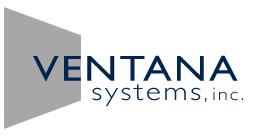Ventana applies the scientific method to solving hard problems: with clients and other available experts we express the best current understanding of how a system operates in the form of a mathematical model. We have no dogma about modeling technique, drawing on many different styles as appropriate. We then apply advanced techniques to available data check whether that understanding correctly describes the real system.
The Radar Analogy
A technically appropriate analogy to Ventana technology is radar, because like businesses, radar systems must make decisions based on contradictory and noisy evidence. In fact, Ventana uses some mathematical algorithms originally developed for missile defense radar systems.
The purpose of a radar system: Based on a number of noisy, indirect measurements, figure out the complete true state of target airplanes. Once you know where they are and where they are going, you have a much better chance of making correct decisions to efficiently manage the airspace.
The purpose of a typical Ventana application: Based on a number of error-prone, indirect measurements, figure out the true state of a market or customer. Once you know how it really works and what its present mindset is, you have a much better chance of efficiently influencing it.
A critical component of each system is a dynamic (differential equation) model that represents the operation of the “target”. For radar systems, it is a model of a maneuvering airplane or warhead. For Ventana, it is a model of how a customer decides whether to buy something, and from whom to buy it.
Any such model consists of four parts:
- State variables. For the airplane target, these include its mass, and its location, attitude and velocity in three-dimensional space. For the customer, typical state variables might include knowledge of products, ownership and usage of products, attitudes, values, habits, and perceptions.
- Variable inputs. For the airplane target, this would be the actions of thrust, control surfaces, and winds. For the customer, inputs include the prices, nature, reputation and “aura” of products presented, and the kinds of information and advertising by which the information is delivered.
- Constant inputs (“parameters”). For the airplane these are the responsiveness of the airplane to maneuvering inputs and winds, the radar reflectivity of the airplane from different directions. For the customer, the parameters describe the relative strengths of various preferences, the speeds by which different attitudes respond to advertisements and experience with the product.
- Uncertainties. The response of the airplane to wind and some controlled inputs is best described as uncertain (noise, lack of information, or bounded uncertainty). The response of customers is similarly variable from one customer to another and through time for a single customer. The uncertainties themselves are usually modeled in ways that lead to more parameters, such as the variances and co-variances of various uncertainties.
Both radar systems and Ventana then surround the model with additional mathematical algorithms to…
- test the integrity of the model under a wide variety of conditions to ensure robustness,
- use the available data to (indirectly) measure the most likely value of each parameter,
- measure the uncertainty (precision) by which each parameter is known,
- use the available data and the parameter estimates to measure the most likely current state of the airplane or customer,
- use the resulting calibrated model to find the most efficient way to achieve what you want. In the case of the customer, this would be finding the most efficient future inputs to achieve maximum market share, brand loyalty, and profitability.
Much of the above sounds like econometrics, which also makes use of models and data. The primary differences are:
- Econometrics was invented in the 1920s, before computers. Econometricians embraced ordinary least squares (OLS), which makes computational shortcuts by assuming that the data are perfect.
- The econometric algorithms also assume that the data are complete – that all variables in the model are directly measured. The radar and Ventana algorithms assume that only a subset of the model variables are measured (with limited accuracy, at that), and deduce all the others from the measured subset.
